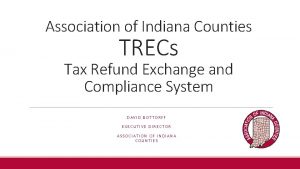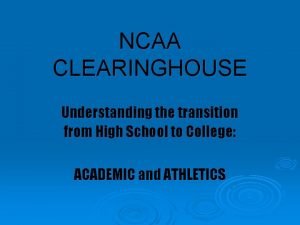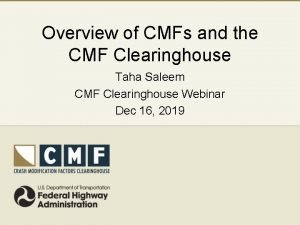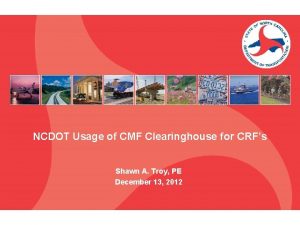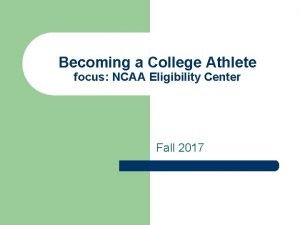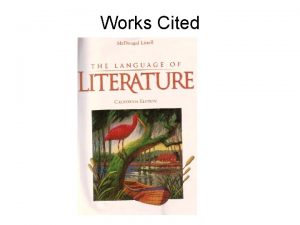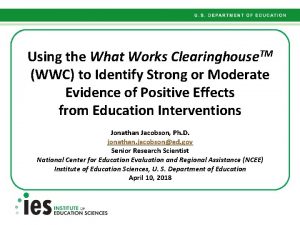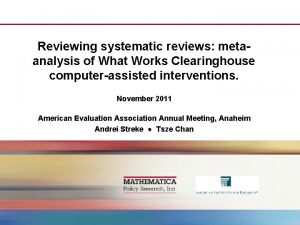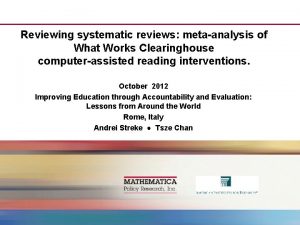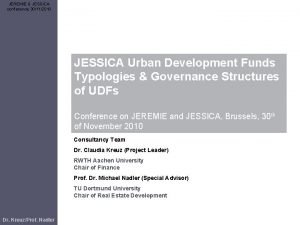What Works Clearinghouse Standards in Research Design Jessica



































- Slides: 35

What Works Clearinghouse Standards in Research Design Jessica Logan, Ph. D. Assistant Professor of Education Studies Quantitative Research, Evaluation, and Measurement Quantitative Methods Brownbag 8/31/2018 Logan. 251@osu. edu

What is the What Works Clearinghouse • The WWC is “a central and trusted source for scientific evidence of what works in education”. • A resource for researchers, practitioners, and policy makers to find information about the effectiveness of curricula or interventions. • Inclusion of an intervention in the WWC is not based on whether the intervention is effective, but whether it was tested in a well-designed causal framework.

Why should you care • Inclusion in WWC is exposure of your intervention idea to a network of researchers, practitioners, and policymakers. • It’s good science. Using these causal research design guidelines gives you a good idea of whether your intervention is working. • IES will now only fund Goal 3 (Effectiveness / ideal conditions) and Goal 4 (Efficacy / large-scale real world implementation) studies if they meet WWC standards

WWC Standards Handbook • Used to determine whether studies are well designed. • During grant reviews • During reviews of study write-ups. • WWC only evaluates studies that are: • • Randomized Controlled Trials (RCTs) Quasi-Experimental Designs Regression Discontinuity Designs Single Case Designs

WWC Standards Handbook • Used to determine whether studies are well designed. • During grant reviews • During reviews of study write-ups. • WWC only evaluates studies that are: • • Randomized Controlled Trials (RCTs) Quasi-Experimental Designs Regression Discontinuity Designs Single Case Designs

Two types of studies • A Randomized Controlled Trial (RCT): • Every person must have a non-zero chance of being enrolled in each condition • Every person must be assigned by chance. • Because of this, treatment and control groups are equated on expectation • Characteristics and potential confounds are randomly distributed between groups. • A Quasi-Experimental Design (QED): • Compare groups that already exist • Each participant must be a member of only one group • These will never be equated on expectation

Gradients of approval • WWC provides three different ratings of levels of evidence: • Meets standards without reservation • Meets standards with reservations • Does not meet standards • The guidelines for whether a study meets WWC standards with or without reservation depends on level of random assignment.

Individual Assignment • Individual assignment means you’re interested in evaluating outcomes at the same level as assignment: • Assign students to conditions and measure student achievement • Assign teachers to conditions and measure teacher turnover • Assign schools to conditions and measure percent of HS graduates • The process to determine whether individual assignment studies meet criteria considers: 1. Random Assignment 2. Sample Attrition 3. Baseline Equivalence

RCT QED

1. Random Assignment • A Randomized Controlled Trial: • Every person must have a non-zero chance of being enrolled in each condition • Every person must be assigned by chance. • Because of this, treatment and control groups are equated on expectation • Potential confounds are randomly distributed between groups. • Eligible to meet WWC standards without reservation • A QED: • • Compare groups that already exist Each participant must be a member of only one group These will never be equated on expectation Can only meet WWC standards with reservation

2. Sample Attrition 1) Overall Attrition Rate • Rules based on Attrition Bias working paper • Bias of d <. 05 considered “tolerable” 2) Differential Attrition rate • Good: If attrition is related to general loss • Students move out of the district • Called “Optimistic” assumption • Less good: If attrition is related to your intervention. • Your intervention is hard and makes students skip school to avoid it • If you (or your reviewer) thinks this is happening, called “cautious” assumption

Similar information In Table II. 1

3. Baseline Equivalence • Baseline: Before the intervention is introduced • Equivalence: Bias of d <. 05 considered “tolerable”

3. Baseline Equivalence • Baseline equivalence: • Must be satisfied for each analytic sample and each outcome domain • Measures used for equivalence must have good reliability • Must be a true baseline measure (not given after the intervention starts) • Best to use pre-test to establish equivalence, but when not possible then use demographic characteristics.

RCT QED

Individual Assignment: Two additional considerations. The study must… 1) At least one outcome measure must meet review requirements • Face validity: Content assessed aligns with the definition - e. g. , don’t use a reading fluency measure to measure reading accuracy. • Acceptable Reliability - Internal consistency (e. g. , Cronbach’s alpha) of. 50 or higher - Temporal stability (e. g. , pre-post test) of. 40 or higher - Inter-rater reliability (e. g. , percent agreement; kappa) of. 50 or higher • Not Overaligned - Primary outcome can’t be what is explicitly taught • Outcomes collected in the same manor for treatment and control groups - e. g. , don’t collect the treatment group first and the control group second. From WWC V 4. 0: Chapter IV

Individual Assignment: Two additional considerations. The study must… 2) Must be free of confounding factors: • Intervention or comparison group must have more than one person • Characteristics of the participants in each group must not differ systematically - e. g. , intervention is all grade 7 and control all grade 6. - e. g. , intervention is English language learners, control all not • Intervention can not be offered in combination with another intervention - e. g. , intervention is of intervention A, but the treatment group also gets intervention B. The control group gets neither intervention - The treatment response recored could be A, B or a combination of A and B. From WWC V 4. 0: Chapter IV

Group (Cluster-Level) Designs

Group (Cluster-Level) Assignment • In cluster-level assignment studies, you assign a higher-level unit to conditions, then measure outcomes in lower-level units: • Assign teachers to conditions, measure outcomes for students • Assign schools to condition, measure outcomes for teachers • Four primary steps to establish quality of group-assignment studies: 1) 2) 3) 4) Is it (a) Cluster Randomized with (b) Low Cluster-level attrition Bias for cluster entry Bias for “nonresponse” of individuals Baseline equivalence

NO Continues…

1 a. Cluster Randomized 1 b. Low cluster-level attrition A) Clusters must be randomly assigned to conditions • Each cluster has a non-zero probability of being assigned to each condition • Assignment is by chance B) Cluster-level attrition must be low • Cluster-level = level of assignment • Low = Same definition as individual trials (<55%; < 64%; >64%) • What counts as attrition? • Cluster-level units who drop out of the study after being randomly assigned.

2. Bias for individuals entering clusters • These individuals are called “Joiners” • Bad because post-random assignment, joiners may not be random. • Might be joining because they heard this cluster has a cool new intervention. • Or so they don’t have to do study activities. • How to fix: • Don’t allow anyone to join clusters late (or at least don’t include them as your analytic sample) • Allow, but you need really good justification that the joiners will be random.

3. Bias due to individual non-response • Means individual-level attrition • If a cluster left the study (step 1), these individuals don’t count towards individual non-response percentage. • Low attrition = same as previous figures (<55%; < 64%; >64%) • If these are met, then congrats! You meet WWC without reservations! • If not…

4. Baseline equivalence • Same as before. • If you need to adjust, most effective: • Use ANCOVA or Gain Scores • Only when pre/post are measured in the same units • Use a baseline characteristic that’s correlated at least at. 6 with the outcome • If you don’t satisfy the baseline equivalence requirement…



Steps 5 -7 • These are really only considered if you expect to have very poor response at follow-up. • Basically, a re-examination of the attrition rates (steps 5 -6). • If your cluster-level attrition rates are high, you can still save it if you can establish baseline equivalence for a subset of your data.

Missing Data • In every study, you should expect you’ll have some missing data. • Important to document how you will deal with it. • WWC has a few acceptable approaches:

Missing Data: Acceptable approaches A) B) C) D) Complete case analysis. Delete incomplete cases. Regression imputation (must be bootstrapped standard errors) Maximum Likelihood Estimation Non-response weights • For all but option A, you need to provide extensive documentation for your choices. (Table II. 6). • With your missing data choice documented – demonstrate you still meet WWC standards:

Continued…


Example Writeup • From pending IES grant • Cluster-randomized control trial

What Works Clearinghouse Standards (WWC). We have designed the evaluation to meet WWC standards without reservation (IES, Version 4, 2017). (1) RCT design with low cluster-level attrition. Per WWC, total attrition is tolerable when at or below 30%. Maximum expected overall attrition in the present study is estimated at 19. 5%, based on district teacher turnover rates between school years. We will also monitor WWC standards for tolerable differential attrition <5%. We expect differential cluster-level attrition at 1 -5% based on a recent three-year IES efficacy study directed by co-investigator (XXX) in this same district. With 105 initial classrooms, only 2 attrited and differential attrition was <1%.

• (2) Minimal risk of bias due to individuals entering clusters. Our inclusionary and exclusionary criteria are set prior to study recruitment, therefore minimizing potential introduction of sample bias as such exclusions will not count towards attrition (WWC, p 12). The reference sample for this study will be the original randomized sample (WWC, p 26). Eligibility criteria of focal students requires children to be enrolled in a given classroom prior to random assignment so that potential “joiners” will not be eligible fore participation. • (3) Minimal risk of bias due to individual non-response For child-level differential attrition, previous work by co-investigator XXX found no difference in attrition between groups (7. 0% for BAU, 7. 2% for Tx; t[827] =0. 15, p=. 88, Cohen’s d =0. 01. ) • (4) Establish equivalence of individuals at baseline. We will test for and likely establish baseline equivalence on key outcomes (xxx). As the conditions will be randomized, we have no reason to expect that between-group differences will be observed, and therefore expect to meet WWC standards without reservations.

 Streetworks revision
Streetworks revision Closed question example
Closed question example National student clearinghouse student tracker
National student clearinghouse student tracker Competency model clearinghouse
Competency model clearinghouse Background screening clearinghouse login
Background screening clearinghouse login Trecs local gov clearinghouse phone number
Trecs local gov clearinghouse phone number Clearinghouse applicant initiated
Clearinghouse applicant initiated National student clearinghouse student tracker
National student clearinghouse student tracker Results first clearinghouse database
Results first clearinghouse database Ncaa clearinghouse paperwork
Ncaa clearinghouse paperwork Fastener clearinghouse
Fastener clearinghouse Fdp expanded clearinghouse
Fdp expanded clearinghouse Carisk intelligent clearinghouse
Carisk intelligent clearinghouse Affordable housing clearinghouse
Affordable housing clearinghouse Ifta demographics
Ifta demographics Tesia clearinghouse
Tesia clearinghouse Vgin clearinghouse
Vgin clearinghouse Cmfclearinghouse
Cmfclearinghouse Cmf troy
Cmf troy Clearinghouse cbus
Clearinghouse cbus Competency model clearinghouse
Competency model clearinghouse Ncaa clearinghouse worksheet
Ncaa clearinghouse worksheet Ifta clearinghouse
Ifta clearinghouse Kt clearinghouse
Kt clearinghouse Cmf clearinghouse
Cmf clearinghouse Ncaa clearinghouse 2017
Ncaa clearinghouse 2017 Methodology vs research design
Methodology vs research design Research design qualitative
Research design qualitative Methodology errors
Methodology errors Exploratory research types
Exploratory research types Qualitative research design
Qualitative research design Factors necessary for service standards are
Factors necessary for service standards are Warehouse area calculation
Warehouse area calculation Sqa expressive evaluation template
Sqa expressive evaluation template Sqa understanding standards art and design
Sqa understanding standards art and design Road design standards
Road design standards





